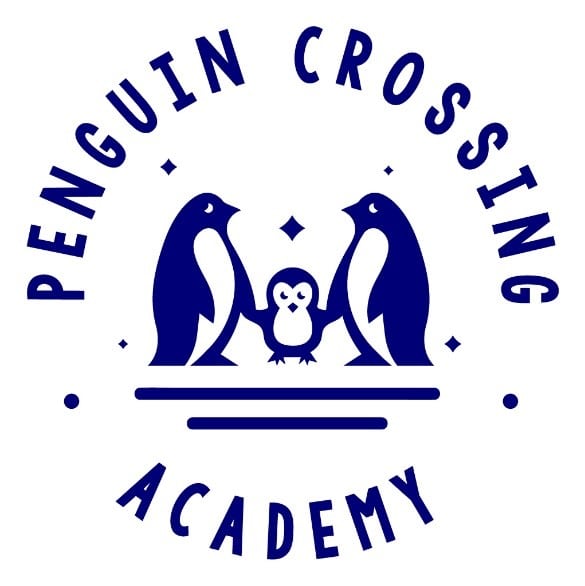3 Reasons Summer is the Best Time to Enroll Kids in Daycare
If you’re considering putting your child in daycare, you may be wondering when is the best time to enroll. While Penguin Crossing Academy takes children as young as six weeks, most pediatricians consider six months to be the youngest beneficial age to enroll an infant in daycare.
Parents of early preschool children (around the age of three to five) who seek to enroll their child in an early educational program consider the beginning of the school year to be the best time for enrollment. However, there are compelling reasons to enroll during the summertime before the school year begins. Let’s examine each below!
Gradual Change
Change is hard for young children, especially if they have stayed home with a parent all their life. Starting school in the fall is an overwhelming change and they may not grasp academic concepts like they should because they’re trying to learn the schedule and new social rules. This can put them behind before they can even get started!
Enrolling a child in a daycare program over the summer will help them better prepare for an academic experience in the fall. Children can become accustomed to a daytime routine without their parent, so going to school won’t feel overwhelming. This will yield better academic results because the child will be comfortable and able to focus on their learning.
Penguin Crossing Academy offers enrollment on a full or part-time basis, which means that your child can attend Penguin Crossing Academy a few days a week. This is the perfect solution for a shy child! They can still have a few days with their parent but gradually ease into a full-time schedule by the fall. This boosts the child’s confidence, which allows them to focus on their education.
Even better, Penguin Crossing Academy has an early preschool program, so your child doesn’t have to learn any new routines, teachers, or friends in August. They can stay in their new comfort zone, which makes the schooling experience less stressful for your child–and you!
Summer Work Solution
Most jobs don’t take a summer vacation, which makes childcare challenging for many parents! Even if you wanted to stay home with your child every day, practically speaking, it’s impossible: you still need to work.
You might be able to juggle a childcare schedule between relatives, friends, educational camps, and VBS events, but it’s a Jenga puzzle that could collapse the moment the adult slated to watch your kid gets sick, has car trouble, or has to work a longer shift. What happens to your child and your job?
The far simpler solution is to enroll your child in Penguin Crossing Academy. We are open 7 AM-6 PM, which gives you tremendous flexibility to get all your work (and a few child-free errands) done so you can be fully present with your child when they are home.
Unlike the constant shuffling of babysitters, Penguin Crossing Academy is open rain or shine to care for your child. You can rest easy knowing that you have a reliable childcare solution.
Our teachers will be consistently familiar faces instead of a shuffling of babysitters. Many parents and children enjoy the relationships they build at Penguin Crossing Academy so much that they continue with after-school care once school begins!
Prepare For School
There’s a lot that goes into being academically successful.
For children entering their first year of formal schooling, there are many things adults forget that are challenging to children. Things such as standing in a line, keeping your hands to yourself, raising your hand to ask a question, being quiet while the teacher is talking, and so much more, are skills that are not naturally taught at home.
Children must have a classroom experience–sometimes learning through trial and error–to fully grasp these concepts.
Many first-day jitters are also due to new people and relationships. Children who have never made a friend without a parent’s help may feel intimidated and awkward around peers, and this can cause a lot of anxiety in children. Enrolling your child in daycare during the summer will help them learn essential friendship skills that will benefit them when school starts.
Children who don’t know these basic skills are at a disadvantage when they begin school. Most of their first few weeks may be predominantly learning new social and scheduling rules instead of academics.
Instead, children who are enrolled in an early preschool program have confidence walking into their first day of kindergarten. Their educational experience will be enriched because they know how to make friends, listen to their teacher, sit quietly, follow a routine, and much more.
These are just a few reasons why enrolling children in Penguin Crossing Academy during the summer is a wise childcare choice.
Tricks for Getting a Child to Nap Every Day
If there’s one thing every parent can relate to, it’s getting your child to nap. Even if you consider your child a great sleeper, at some point, they will struggle to nap. When a child misses their nap, it can make them overtired, which only perpetuates the sleeping problem.
So how can you make it easier for your child to nap every day? Keep reading for age-specific tips!
Why Do Children Need Naps?
Babies and young children are learning about their bodies and the world around them every moment of every day. Quite literally, every day they are learning something new!
Humans process new information and store memories during sleep. Because young children are constantly experiencing and learning new things, they need extra sleep to integrate and remember them.
The brains and bodies of young children literally grow during sleep! So if you want your kid to be strong and smart, adequate sleep is vital.
How Much Should My Child Sleep?
Babies, toddlers, and young children all benefit from naps throughout the day. How many naps or how long they nap for depends on their age.
- Newborns (0 to 3 months) need 14 to 17 hours of sleep per day. They take about four to six naps a day for about 30 minutes to two hours at a time.
- Babies (4 to 12 months) need 12 to 16 hours of sleep per day. Babies sleep for longer stretches at night. At 6 months, babies usually drop to two naps: one in the morning and one in the afternoon.
- Toddlers (1 to 2 years) need 11 to 14 hours of sleep per day. Before the 18-month-mark, toddlers still take two naps. However, around 18 months they transition to one longer, afternoon nap.
- Preschoolers: (3 to 5 years) need 10 to 13 hours hours of sleep per day. Some children stop napping between 3 and 4 years old, but others will still nap regularly until age 5.
- School-aged children (6 to 12 years) need 9 to 12 hours of sleep per day. By the age of 6, children no longer need to take a nap, getting all their sleep at night.
Tips for Helping Your Child Sleep
While every child is different, some general principles will help every child nap, no matter their age.
Avoid Overtiredness
While you might think that an exhausted child will sleep longer, this is simply not true. Exhausted, overtired children are in overdrive and will use this cranky energy to fight sleep. If your child isn’t getting the recommended hours of sleep (listed in the section above), then it’s likely that they’re fighting sleep because they’re overtired.
You can overcome overtiredness by setting firm boundaries on bedtime and nap time. It takes consistency, but setting a firm bedtime and nap time every day will help your child regain their lost sleep and settle into an ideal routine.
Time It Right
Children have natural wake and sleep windows, and taking advantage of when they’re naturally sleepy will make it much easier to get them to nap. Take note of when your child starts slowing down: choosing quieter toys, reading books, zoning out, or being easily irritable.
Babies and toddlers who take morning and afternoon naps will generally need a nap about two hours after waking up. Children this age should take a 1.5-2-hour nap in the morning and afternoon.
Toddlers and young children who only take an afternoon nap generally do best with their nap about a half hour to an hour after their midday meal. This is because the short-term energy from their food has worn off. Children this age can take a nap from 1-3 hours, depending on how many hours they sleep at night.
Be Consistent
It’s tempting to not require your child to nap every day, but there are a few problems with inconsistency.
First, your child will slowly build up a sleep deficit that will result in them being overtired. As seen above, overtiredness comes with its own set of challenges. Secondly, children thrive on consistency. If they never know when they need to take a nap, it’s easy for them to resist in various ways.
An added benefit of consistency is the parents and caregivers have predictable times throughout the day to rest or accomplish tasks.
Use Sleepytime Tech
There are plenty of excellent assistive tech devices that can help your child sleep. For instance, a simple noise machine that plays soothing sounds like the ocean, rain, or other white noise can help lull your child to sleep. Another smart device is to invest in a clock (like this one) that glows when nap time is over.
As children get older and transition away from sleeping every day, they may benefit from listening to a story in their bed. If they fall asleep, then they are tired enough, and if not, they at least get some rest.
Getting your child to nap can be a challenge! But the most important thing is to be consistent with a daily routine to avoid sleep deficits and tantrums.
Fun and Healthy Snack Recipes to Try at Home
Every parent can relate to the frustration of their child frequently asking for a snack. Sometimes, it seems like kids want snacks every few minutes!
While it’s easy enough to provide packaged snacks or easy fruits like apples and bananas, this can get expensive quickly!
Plus, the ingredients and additives in many packaged snacks can make your child’s food cravings worse.
Dyes like Red #40, Yellow #5, and Blue #1 are found in many packaged snacks, especially those marketed to children because their vibrance is attractive. But these dyes are detrimental to human health: they are carcinogenic and are linked to behavior problems, ADD/ADHD, and so much more.
Other ingredients like sugar (and their lesser-known names like high-fructose corn syrup, sucrose, fructose, etc.), seed oils, preservatives, artificial flavorings, and more, can have negative effects on childhood development, increase the risk of obesity, and more.
What Makes a Good Snack?
There’s a lot of health and diet advice out there! But basic science concepts can be applied to choosing a healthy snack.
We all know that sweet things–sugar and sweeteners, but also substances our bodies process as sugar like wheat and dairy–spike our blood sugar. We get that burst of energy and feel alert and in a good mood, but it’s only a matter of time before we feel sluggish and cranky again.
This blood sugar roller coaster happens when there isn’t a healthy fat to slow the absorption of sweeteners. Not all fat is bad, and when healthy fats are eaten in moderation, are actually very beneficial. They keep you full for longer, so you actually eat less–which is good for your budget and waistline!
Not to mention, children need healthy fats to grow strong minds and bodies!
A good snack for children will combine something yummy and fun with healthy fat or protein to slow the absorption and keep your child full for longer.
Here are some fun, yummy, and healthy snacks that your kids will love!
Chocolate Hummus
While beans in a sweet dip may some like a bad mashup, don’t pass this recipe over before giving it a try! 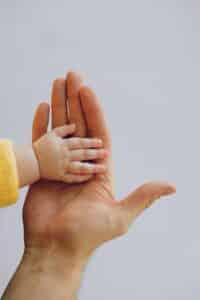
This healthy dip can be served with a variety of sweet and salty dippers like fruit slices, pretzels, or crackers. The protein in the garbanzo beans or chickpeas slows down the sugar in the honey (or fruit dippers) so your child stays full for longer. Just blend these ingredients well:
- 1 can (15 oz) garbanzo beans or chickpeas
- 1/3 cup unsweetened vanilla almond milk
- 1/4 cup baking cocoa
- 1/4 cup honey
- 2 teaspoons vanilla extract
Yogurt Fruit Cups
Sweetened yogurt and fruit is a classic snack combination and irresistible for children and adults alike. The protein and healthy fat in the yogurt keep tummies full for longer than fruit alone. Plus, this snack is simple to prep and store a week’s worth of yogurt cups in your fridge for a super easy and delicious snack!
- 4 cups cut-up fresh fruit or berries
- 3/4 cup vanilla yogurt
- 1 cup granola (optional)
Evenly distribute the fruit amongst five single-serving cups. Spoon the yogurt evenly over the fruit. If using, portion granola into snack baggies to keep fresh until consumption. Keep refrigerated.
Peanut Butter Date Energy Balls
These energy balls are the perfect size for little hands that taste like a cookie without giving your child the sugar crash of a sugar-sweetened snack. 
- 1 cup dates, pitted
- 2/3 cup natural peanut butter
- 1/3 cup oats, quick-cooking or rolled
- 1 tsp vanilla extract
- 1 Tbsp chia seeds
- 1/4 cup mini chocolate chips, dairy-free if needed
Soak the dates in warm water for about 10 minutes. Drain the dates and blend them in a food processor. Once smooth, add the peanut butter, oats, vanilla, and chia seeds. Blend until the consistency is firm but pliable enough to roll into a ball. Add more oats if the batter is too sticky, or add more peanut butter if it is too dry.
Add the chocolate chips and mix with a spoon. Portion batter into 1 tbsp balls and store in a container in the refrigerator.
Frozen Yogurt Bark
If your kid is always wanting ice cream or popsicles, try swapping out this frozen yogurt bark instead. It gives your child the same enjoyment of a sweet frozen treat without the sugar and artificial flavors.
- 2 cups vanilla yogurt
- 1 cup blueberries
- 1 cup sliced strawberries
- 1 cup granola
Line the baking sheet with parchment paper. Spread the yogurt evenly on a baking sheet. Then sprinkle the berries and granola evenly onto the yogurt. Freeze for at least 3 hours, or until firm. Break into pieces and keep frozen until serving.
Growing children need to snack throughout the day to meet their dietary and energy needs. It’s your job as a parent to choose snacks that keep them healthy.
Developmental Toys Your Children Will Love
If you haven’t noticed by now, your child grows and matures at a rapid speed! While this is most noticeable in the infant and toddler years, children of all ages are making many neurological connections that will aid them for the rest of their lives.
Children learn primarily through play. Playtime is their “school” or “job” to develop the skills they need later for their actual schooling and occupations. When you see playtime as education, then you’ll want to provide your child with toys that grow their brains, bodies, and language skills.
Should All Toys Be Educational?
Not necessarily, but most of them should be.
Toys shape your child’s understanding and interpretation of their world. If every toy has lights, noises, music, or some technology component, they won’t be satisfied with anything that isn’t interactive in later years.
To give another word picture, toys are the “food” that nourishes your child’s brain, body, and language development. Children who grow up playing with open-ended toys (that is, toys that can be used in more than one way, like blocks) are more likely to be curious, have excellent problem-solving skills, and be more content, than children who play with highly-stimulating or tech-based toys.
If toys are like food, then open-ended toys are like the nutritious parts of a meal and tech toys are like dessert. They can be permissible, even more than once a day, but shouldn’t be your primary nutrition source.
How Your Child Develops
You must remember that your child develops in three primary areas: cognitive (which includes emotions), physical, and speech/language skills.
Cognitive development includes areas like problem-solving, decision-making, abstract thinking, and emotional regulation.
Physical development would be both gross and fine motor skills. Gross motor skills are big movements, like walking, running, jumping, climbing, etc. Fine motor skills involve picking up or manipulating small objects purposefully.
Speech and language skills include growing a vocabulary, developing sentence structure, and comprehending what others are saying.
A developmental toy will encourage growth in one or more of these areas.
Developmental Toys for Babies
The best developmental toys for babies are those with high-contrast colors. This is because their vision is still developing, so toys with bright or high-contrasting colors (like black and white) and bold patterns will grab and keep their attention. Playmats with mobiles are great for newborns, while blocks, stacking rings, and rattles are good choices for older babies.
Toys with various textures are another excellent option, as babies want to touch everything–and put it in their mouth! Many wonderful sensory books provide different textures and crinkly or squeaky sounds. However, ensure that toys and books don’t have any small pieces that a baby can choke on.
Once your child begins to be mobile, push and pull toys will help develop their gross motor skills. For speech and language development, simple books are the way to go. Baby books don’t even need a story; books that show pictures of everyday objects help them learn new words. Pointing to the objects and giving your own commentary is sufficient.
Developmental Toys for Toddlers
Children at this age crave toys that develop their cognition. Puzzles with large pieces, blocks, and matching games combine cognitive development with gross and fine motor development.
Toddlers also begin to love creating artwork. Simple art supplies are an excellent way to develop sequencing skills (first dip the paintbrush into the paint, then paint the picture), fine motor development, and creativity. Age-appropriate supplies include crayons, paint sticks, paint brushes, or markers. Just ensure that any art supplies are non-toxic, as children often try to taste them.
To develop your toddler’s speech skills, puppets, dolls and action figures, and kitchen sets let your child utilize their growing vocabulary. Age-appropriate books introduce new words, help build sentence structure, and reinforce their understanding of words they already know.
Developmental Toys for Young Children
Pre-K children have more developed cognitive, motor, and language skills and can do highly coordinated activities. They can do many of the same activities as toddlers but on a higher level. For instance, puzzles with interlocking pieces, magnetic tile pieces for building structures, and Duplo or LEGO blocks.
Children at this age benefit from tripod scooters, balance bikes or tricycles, or bicycles with training wheels to improve their gross motor skills. For fine motor, you can choose more challenging art projects, such as paint-by-numbers, scissor activities, stickers, or tracing.
Keep reading age-appropriate books to develop your child’s language skills. They may also benefit from an interactive toy that teaches letters, letter sounds, numbers, a second language, and more.
Choosing the right toys for your child is just as important as choosing the right foods. While everything is alright in moderation, you still want your child to eat their fruits, veggies, grains, and proteins. Don’t give your child just tech-based toys–instead, choose a variety of toys that develop their cognition, motor skills, and language skills.
How Important is Story Time in the Evening?
Parents and teachers intuitively know that children benefit from being read to, but how important actually is story time?
The science has proven that reading to children benefits them immediately and in the future! Children who are read to have:
- Better language skills – Quality literature improves language understanding, grammar, and sentence structure
- Increased vocabulary – Quality literature exposes children to a wide vocabulary and better understanding of words
- Improved literacy – Research shows a strong connection between reading aloud to children and advanced literacy skills.
- Emotional bonding with parents – positive connections are made between a parent and the child during read-aloud
Here are a few suggestions for finding time slots for reading to your child. Be sure to read to the end to learn the best time of day to read to your child!
Early Morning Reading
Every child is different. Some are bouncing off the walls as soon as they wake up, while others are sleepy and want to cuddle. If your child is an early-morning cuddler, then this is an excellent time to read with your child!
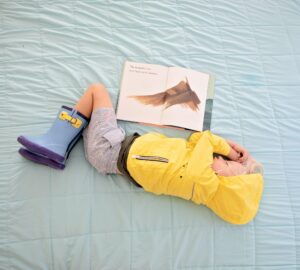
What a sweet rhythm to have with your child first thing in the morning. Cozy up with a blanket, some books, and something to drink or eat. This will quickly become one of your favorite parts of the day and cherished memories.
Even if your child is like an unleashed tiger in the early morning, you can still have early morning reading. It can even be an excellent way to teach your child self-regulation. Children want to engage with you, and while you might not be ready to wrestle at 6 A.M., they may be willing to snuggle up with a good book.
Mid-Morning Reading
By mid-morning, babies are ready for their first nap of the day and young children have burned through their energy from breakfast. For babies, taking just a few minutes to read to them before naptime is a signal to them that it’s time to sleep. You can even read to them while they drink their bottle!
Young children may have burned through their breakfast energy and are poking around for something to do or eat. Children need to engage with their parents frequently and often turn to their parents to help them regulate their emotions. This might take the form of mischief or whining, so it can be easy to turn to technology or snacks to get over the mid-morning hump.
However, remember that children want to engage with you, not technology. Taking a few minutes to read will give them the emotional regulation their bodies are craving, and you may be surprised that they aren’t as needy for technology or snacks as you previously thought. Often after reading, children are regulated and ready to choose their next activity with cheerfulness and independence.
Before Nap Time
Babies, toddlers, and young children should have regular naps. Often, children of these ages will take a nap in the early afternoon. This is another perfect time to sneak in some reading!
As your child starts to slow down, choose quieter activities, or zone out, initiate some reading time. Take the child to a cozy spot such as their bed or a rocking chair, and read one to three books. This further relaxes your child, gives them a visual timeline of when it’s time to nap (“This is our last book!”), and helps them fall asleep faster.
After Nap Time
Some kids struggle to wake up from a nap. They can be grouchy, sleepy, or whiney. But cuddling and reading a book while eating a snack is sure to chase away the nap-time blues! 
Similar to early morning reading, cuddling with your child and reading a book helps ease them into wakefulness again. A healthy snack or drink also helps gently raise blood sugar and mood so they are cheerful after reading together.
Before Bed
Science is now showing that reading before bed is the best time to read with your child. In one study, reading at bedtime significantly improved total nighttime sleep duration. If there’s one thing parents want, it’s for their kids to sleep deeper and longer!
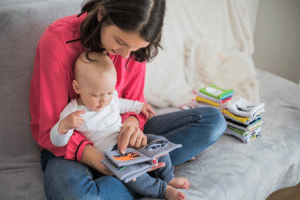
With sleepiness to keep them relaxed and fighting sleepiness to keep them alert and engaged, reading at bedtime gives you the best bang for your buck. Reading with your child before bed helps establish a stable routine, promotes bonding, and gets them into a sleepy state of mind to fall asleep–and stay asleep!
What Is Quality Literature? (Plus Age-Appropriate Book Guide)
You may have heard about the importance of reading to your child, but what books are best? Are they all created equally? How important is it to read quality literature?
Quality literature opens your child’s world, inspires their imagination, and helps them learn grammar, sentence structure, vocabulary, art appreciation, and social and emotional skills. They can also learn facts in school subjects like history, science, geography, math, social studies, and so much more!
What Is Quality Literature?
What exactly is quality literature? This might conjure up ideas of Shakespeare or famous poets, but thankfully, these are not the only kinds of quality literature. 
Literature is like eating a meal. While dessert isn’t off limits, most of the meal should be something nutritious, like protein, fruits, veggies, dairy, and grains. Quality literature is like the nutritious part of the meal: you want your child to be reading (consuming) the best literature to grow their minds, imaginations, and educational skills.
A book would be considered quality literature if it includes all (or most) of the following:
- Well-written, interesting stories: Some stories are too simple, don’t make much sense, or don’t provide a positive message.
- Age-appropriate words: Most of the words should be understandable to a child, but quality literature will stretch a child’s vocabulary just a little bit.
- An overall positive message or conflict is resolved: Quality literature often has role models, teaches life lessons or positive character quality, or has inspiring themes. Conflict resolution is also important.
- Illustrations are detailed: Interesting illustrations draw children back to the book because they want to look at the pictures. Detailed illustrations allow you to discuss the pictures, which further expose your child to language understanding.
- Has won an award: Outstanding books are awarded every year. Some popular awards are the Randolph Caldecott Medal, Coretta Scott King Book Awards and Pura Belpré Award.
In summary, if you (or your child!) want to read the book more than once, it’s likely quality literature.
What’s not quality literature? Here are a few things to avoid when choosing books:
- Trending animated characters: Whether it’s talking trains, classic princesses, or the next trending movie or TV show, these are not quality literature. Children may want to read these books more than once, but it’s not because the literature is quality.
- Graphic novels: While not all graphic novels are bad, these can be a crutch that cripples children from making the transition from picture books to chapter books. The plot lines are often shallow and feel too much like a cartoon to be taken seriously.
These types of books would be the “desserts” of literature: they are fine in moderation but shouldn’t be a child’s only exposure to reading.
Finding Quality Literature
It’s easy to find quality literature for story time! While you should purchase some of your favorite books, you can find most books through your local library.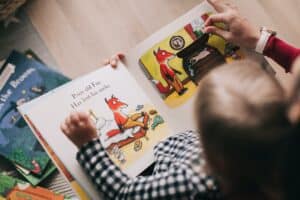
Type in “quality literature + age of your child” into a search bar for thousands of options for quality books. You can request dozens of these books at a time from the library.
You can also ask your librarian for suggestions. They will know of classic books as well as new award winners and recent releases.
If you’re expecting a new baby, register for some classic children’s books, even if they’re not baby books; you’ll be happy you have them later.
Another option is to buy classic books for Christmas, birthdays, or holiday gift baskets. While these might get passed over at first for candy and toys, the books will be what your child wants later!
Here are some age-appropriate quality literature books for young children.
Infant
- Ten Little Fingers and Ten Little Toes, by Mem Fox.
- Baby Bear, Baby Bear, What Do You See? by Bill Martin Jr.
- I Am a Bunny, by Ole Risom
- Mommies Say Shhh! by Patricia Polacco.
- Peekaboo Bedtime, by Rachel Isadora.
- Pat the Bunny, by Dorothy Kunhardt
- My Farm Friends, by Wendell Minor.
- The Very Hungry Caterpillar, by Eric Carle
- Moo, Baa, La la la, by Sandra Boynton
- Chicka Chicka Boom Boom, by Bill Martin Jr
- Goodnight, Moon, by Margaret Wise Brown
- The Tale of Peter Rabbit, by Beatrix Potter
- The Snowy Day, by Ezra Jack Keats
Toddler
- Mike Mulligan and His Steam Shovel, by Virginia Lee Burton
- Corduroy, by Don Freeman
- The Little Red Caboose, by Little Golden Books
- Llama, Llama, Red Pajama, by Anna Dewdney
- Little Blue Truck, by Alice Shertle
Pre-K
- Madeline, by Ludwig Bemelmans
- The Story of Ferdinand, by Munro Leaf
- Green Eggs and Ham, by Dr. Seuss
- Are You My Mother?, by P.D. Eastman
- Make Way for Ducklings, by Robert McCloskey
- Blueberries for Sal, by Robert McCloskey
Go a Little Deeper
As you read a book with your child, ask age-appropriate and thought-provoking questions or commentary before turning the page.

For instance, if a picture has animals in it, tell your baby or toddler what sound it makes. If your child is older, ask them what sound it makes. You can also tell young children about colors, shapes, and numbers, as well as spacial concepts like up and down, in and out, and over and under.
Older children can also make social and emotional connections through stories. If a picture shows a character who is sad, happy, or surprised, ask them why they might feel that way. Or if there is conflict in the story, ask your child what should happen to make things right.
Technology Can’t Replace the Parent
If you want your child to experience the benefits of reading but don’t have the time to sit down with your child, you might turn to audiobooks or children’s podcasts. Your library may also have children’s books that read the book aloud to your child.
While these are better than iPads or television shows, podcasts and audiobooks aren’t the same as reading with your child. This is because the emotional bonding over books is lacking; a stranger is reading to your child.
This doesn’t mean that you can never let your child listen to a podcast or audiobook, but if you want your child to fall in love with reading, it’s vital to take the time to read with your child.
Reading quality literature is an enjoyable, bonding experience for you and your child. Incorporating regular reading will be something you never regret.
